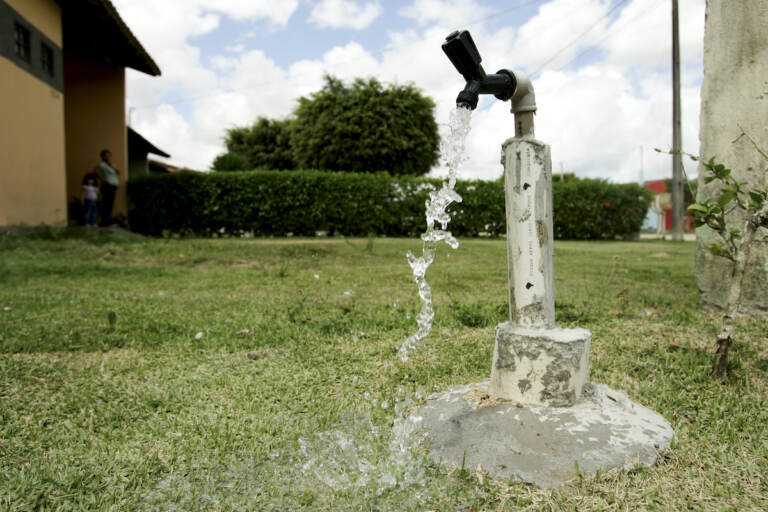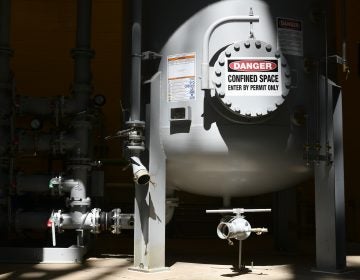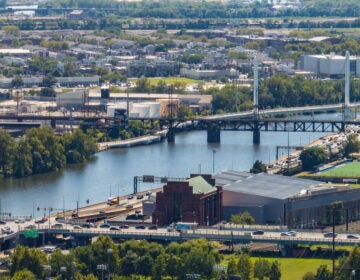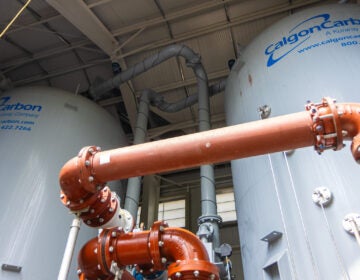How the way we eliminate toxic PFAS from water also takes an environmental toll
Granular activated carbon is most effective at absorbing PFAS, but it contributes to the carbon footprint — a conundrum scientists want to solve.

(joasouza/Big Stock)
The toxic class of chemicals known as PFAS can cause serious health problems, including birth defects and some cancers. So scientists, health experts, and policymakers have been working to reduce our exposure.
Pennsylvania and Delaware recently announced proposals to establish maximum contaminant levels, or MCLs, for the compounds in drinking water. (New Jersey already has them.) That would require water providers to ensure that levels of PFAS in their supplies remain below a certain threshold.
But protecting people’s health has a consequence: The technology most effective at removing PFAS contributes to the carbon footprint.
Currently, there is no other option, so scientists are looking for new methods to eliminate PFAS effectively that won’t contribute to climate change. That way, officials won’t have to compromise the environment while choosing to protect human health.
“We need to hit the and — pure water and be kind to the climate, and not use so much energy. And we need to come up with technologies that can do both,” said Seetha Coleman-Kammula, president and executive director of PFAS Solutions in Delaware. “Not either-or, because we can’t keep putting in a lot of energy for really clean water, and we can’t keep drinking dirty water because we cannot put in a lot of energy — so it’s really the and.”
Granular activated carbon is the mainstay of treating PFAS — shorthand for per- and polyfluoroalkyl substances — as well as organic chemicals. The technology, in the most simplest terms, works when the unwanted compounds are absorbed by the carbon.
To produce activated carbon, which is made from coal, it must be subjected to significantly high temperatures. That process can release carbon dioxide, which contributes to climate change, into the atmosphere.
Then, once the activated carbon is used to eliminate the PFAS, the materials must be disposed of. That’s often done via incineration, or by sending it to a landfill, potentially releasing more carbon dioxide. Activated carbon can be recycled for reuse, but that, too, requires a lot of energy.
The lower the MCLs set for PFAS in drinking water, the greater the potential for environmental impact, because more work would be required to get to a lower level of the compounds.
But there’s no magic number to strike a balance.
“What is the right MCL that’s also good for the planet? I don’t have that answer — I don’t think anybody does,” Coleman-Kammula said.
Currently, there are no federal MCLs for PFAS in public drinking water. The Environmental Protection Agency does set a federal health advisory level of 70 parts per trillion for two PFAS compounds, PFOA and PFOS, but unlike MCLs, the advisory is non-enforceable. Pennsylvania and Delaware are choosing their proposed MCLs based on an estimate of the amount of a chemical a person can eat, drink, or breathe each day without a detectable risk to health. A spokesperson for Delaware’s Division of Public Health said the state isn’t taking environmental impact into consideration simply because there’s no current solution to the carbon dilemma.
Drexel University has received funding from the Strategic Environmental Research and Development Program, part of the U.S. Department of Defense, to research the use of non-thermal (or “cold”) plasma technology to degrade and destroy PFAS into benign products — carbon dioxide and fluoride. That technology, if successful, would solve the current problem of having leftover contaminated materials to deal with.
Even though PFAS are considered a health risk at parts-per-trillion levels, generating parts-per-trillion levels of carbon dioxide and fluoride from the destruction of PFAS would not be dangerous, said Christopher Sales, an environmental engineering professor at the university’s College of Engineering.
Fluoride is often added to drinking water at levels around 1 mg per liter (approximately 1 part per million), Sales said, so the amount of fluoride generated from the destruction of PFAS should be of negligible concern. Similarly, the amount of carbon dioxide produced would also be considered negligible — to put it in perspective, seawater typically has a dissolved carbon dioxide concentration of 40 mg per liter (40 parts per million), Sales said.
“We’re at the early stages of demonstrating and optimizing cold plasma systems for degrading PFAS,” he said. “For destructive technologies, it is important to figure out the mechanisms of how they’re being degraded, and also what byproducts they are producing. Although the goal of these destructive technologies is to produce CO2 and fluoride, we have to make sure they don’t lead to toxic byproducts that are undesirable. We want to make sure we’re optimizing destructive technologies so they not only remove PFAS fast, but also so that they only generate safe byproducts as energy efficiently as possible.”
Dozens of other technologies currently are being researched, he said. “[The science community is] throwing the kitchen sink at PFAS right now and trying to see what works.”
In addition to its impact on the environment, granular activated carbon doesn’t have perfect efficacy for all PFAS compounds, said Yanna Liang, professor and chair of the Department of Environmental & Sustainable Engineering at the University at Albany, SUNY. Though the technology removes PFOA and PFOS pretty well, it is not as successful at removing other types of what are known as short-chain PFAS.
“Unfortunately, we don’t have a perfect solution for dealing with PFAS. I think as researchers, we all try to find that silver bullet,” she said.
Liang’s team is studying a technology that would use plants to take up PFAS from contaminated soil, sediment or surface water, and then use a thermal process to destroy the chemicals accumulated in the plant biomass.
“We want to have a technique or technology that is able to remove all of the PFAS chemicals in either water or soil. And also, we want it to be cost effective, to be environmentally sustainable and friendly,” she said. “So that is our goal. But again, we are still in the process of aiming to achieve that goal, we’re not there yet.”
An alternative to treatment systems
Gerald Kauffman, director of the University of Delaware Water Resources Center, said a long-term solution to reducing PFAS exposure is to drill deeper into aquifers — from the current 100 feet to 200 feet, where the water is clean. PFAS compounds sit toward the top of aquifers, rather than hundreds of feet deep, he said.
Delaware, for instance, could withdraw safe drinking water from the Potomac aquifer that extends hundreds of feet, Kauffman said. It’s part of what’s known as the Atlantic Plain physiographic province, which includes Delaware, New Jersey, and other coastal states, from Long Island, New York, to Florida, and around the Gulf of Mexico to Texas — all areas that would have the ability to drill deeper for water, he said.
Drilling deeper could also apply with other sandy aquifers, such as the Ogallala in the Great Plains of Nebraska, Kauffman said.
Engineers could either use an existing well to drill deeper, or drill another well next to an existing one. A conservative cost estimate for well drilling, plus pumping, is $1,000 per foot, Kauffman said, so drilling an additional 100 feet would cost $100,000.
In the long run, that could be more cost-effective than using a filtration system, he said. Such systems are attached to maintenance costs over time, and if PFAS levels in water become high enough, the work associated would be more costly.
The long-term goal should be to operate without organic chemical treatment, Kauffman said, because cleaner source water is more protective of human health.
“The principle of the Safe Drinking Water Act amendments is that we should be drawing from as pure water as possible and provide minimal treatment. If you drill deeper from the Potomac, you’re drawing pure water — that’s water that’s been down there for tens of thousands of years. What may be in there is a little bit of iron and manganese, which is coming from the sediments, but that’s easily addressed,” he said. “There are many people in Delaware that are drinking water from the Potomac aquifer right now, and they’re drinking pure water that’ll never be contaminated, in my mind.”
“Like most things in the field, it’s science, it’s public health, and it’s cost,” Kauffman added. “This whole issue with PFAS and other organic chemicals that show up is an exercise in balancing all three.”
Though some PFAS compounds are being phased out, they have been widely used in consumer products such as nonstick cookware, flame-retardant and water-resistant fabrics, and some food packaging. Some companies have started labeling products that contain the chemicals, as well as those that are PFAS-free.
Historic use of firefighting foam containing the chemicals at current and decommissioned military bases has had a significant impact on residents in areas such as Bucks and Montgomery counties in Pennsylvania, Monmouth County in New Jersey, and Dover in Delaware. That’s because PFAS, known as “forever” chemicals, do not readily break down in the environment.
The scientists interviewed for this article said it could be a decade before environmentally friendly technology to remove them from drinking water is on the market. In the meantime, the pollution needs to be prevented in the first place, Coleman-Kammula said.
“All the stuff that we released in the past, we are going to be cleaning up forever, doing decades of research. But you’ve got to stop the release of these into the environment,” she said. “Stop PFAS-coated packaging … PFAS in this and that — just stop using them. Ultimately that’s what we have to push for.”
WHYY is your source for fact-based, in-depth journalism and information. As a nonprofit organization, we rely on financial support from readers like you. Please give today.







